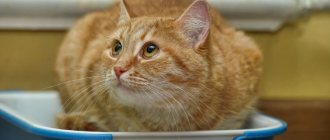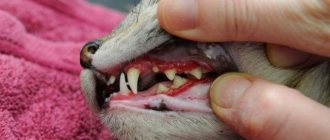All representatives of the cat family are distinguished by natural dexterity and grace, but this property is not always able to protect them from injury. In addition, the world is full of unkind people who may not like these furry fidgets, and therefore are quite capable of causing them intentional harm. Therefore, every responsible owner should be aware of what a concussion is in cats.
Veterinarians note that concussion is not an independent disease, but is only a consequence of the injury received. However, it should not be underestimated, since as a result of a head injury, the animal may experience hemorrhage in the brain or its compression inside the skull. All this leads to dangerous dysfunction of the motor and central nervous systems, which affects the entire life activity of the tailed friend.
The insidiousness of a concussion is that it may not manifest itself in any way for quite a long time, and then suddenly the cat begins to have seizures or develop chronic heart disease on its own. Therefore, owners should remember that even the most insignificant at first glance head injury to a mustachioed friend can have very serious consequences. The article will discuss the causes of a concussion in a cat, and will also discuss the symptoms and treatment of this disease.
Causes of injury
A cat can get a concussion for a variety of reasons. The most common of them is falling from a great height . Despite their agility and ability to always land on their paws, which significantly softens the blow, cats do not know how to circumvent the laws of physics. When falling from a considerable height, they do not die, like other animals, but receive a severe blow, causing a concussion of the brain and spinal cord.
Unfortunately, it is often the person who causes the injury. It can be inflicted accidentally (a blow from a door being opened, a kick while walking) or deliberately. Not all people love these cute animals.
A cat can get a concussion by hitting an obstacle at high speed. This happens when an animal gets scared of something and rushes headlong away. At this moment, there may be an obstacle in its path that the cat, in a panic, does not notice.
Finally, these animals create trouble for themselves . While playing or exploring the surrounding area, animals can throw a heavy object onto themselves, the impact of which can cause a concussion.
Initial activities
MRI, CT (if available);
X-ray of the chest, skull in two projections, cervical spine; IMPORTANT! Every tenth patient with severe TBI also has damage to the cervical spine. Until spinal injury is ruled out, the animal should be managed as having a spinal injury.
Laboratory tests: complete blood count, blood glucose, blood gases and electrolytes, creatinine and blood urea, complete urinalysis; monitoring: general clinical – blood pressure, heart rate, respiratory rate, ECG, blood saturation; neuromonitoring – ICP, EEG, transcranial Doppler echography.
What happens when you get a head injury?
Falls from heights and blows to the head lead to disruption of the central nervous system of the animal. A severe concussion in a cat is equivalent to a brain contusion. That is, in a limited area of the brain, organ tissue is damaged. Along with the immediate impact zone, the brainstem and hypothalamus are affected.
Strong impacts cause destruction of brain tissue both at the site of impact and at the opposite wall of the skull. A concussion disrupts the functioning of vital centers. Blood circulation may be impaired. In severe cases, a severe concussion in a cat is accompanied by hemorrhages in the brain tissue and necrosis.
Diagnostics
In most cases, to make an accurate diagnosis, the veterinarian only needs to examine the furry patient and interview his owner. But in order to prescribe the correct treatment, it will be necessary to clarify the type of pathology, the degree of brain damage and a number of other important indicators. For this, additional tests are prescribed:
- laboratory analysis of blood and urine;
- magnetic resonance imaging;
- computed tomography.
These are the most effective diagnostic methods available today. They allow you to accurately identify a stroke and find out which parts of the brain it affected.
Spinal cord concussion in a cat
This injury most often occurs due to a fall from a great height. When the spinal cord is concussed in cats, the functioning of the pathways is disrupted, which causes problems with the functioning of any part of the organ. For example, if brain function is disrupted in the area of the cervical thickening, then the cat will experience paralysis of the limbs and parts of the internal organs. However, the animal will continue to live, so the brain will ensure the functioning of the lungs and heart. If a concussion of the spinal cord causes disruption of its functioning at the level of the 4th and 6th pairs of nerves , then the animal is likely to die, since this pathology will lead to paralysis of the respiratory center.
Drug therapy
Stroke itself cannot be cured, since it is a consequence of other pathologies. Therefore, therapy is aimed at eliminating the factors that provoked it and restoring normal blood circulation in the brain.
First of all, the animal is given infusion therapy (drips) aimed at restoring the body and preventing dehydration. After the cat’s condition has stabilized, symptomatic treatment is prescribed. It allows you to strengthen the walls of blood vessels, improve the functioning of neurons and prevent their further death. For this purpose they prescribe:
- Prednisolone. A hormonal drug that effectively eliminates swelling and inflammation.
- But-shpu. The product eliminates spasms and pain caused by them.
- Glucose. Provides additional nutrition to body cells, primarily neurons.
- Neuromidin. Helps restore impulse transmission between nerve cells.
Depending on the clinical picture, the animal may be prescribed other drugs, for example, diuretics, antibiotics or antiemetics. In case of significant oxygen starvation, oxygenation is carried out. To do this, the animal is put on a breathing mask or placed in a special chamber with a high oxygen content.
Symptoms of Concussion in Cats
The most characteristic symptom for this injury is loss of consciousness immediately after the blow. The animal remains unconscious for several minutes, then comes to its senses. However, if there is a brain injury, the cat may fall into a coma. The severity of the concussion can be determined by the duration of unconsciousness. The longer the cat does not come to its senses, the more severe the injury and the more dangerous the consequences.
After the return of consciousness, the cat has poor spatial orientation for quite a long time. In some cases, memory loss may occur. The cat is afraid of the owner, does not recognize him, and can even show aggression.
You should contact your veterinarian immediately if your cat exhibits the following symptoms:
- The pupils have different sizes.
- The pupils react poorly or not at all to light.
- There are rapid, unpredictable movements of the pupils.
- A cloudy spot appeared on the pupil. The iris is shaking. This may indicate possible displacement of the lens due to ligament separation.
- Bruises were found on the head.
- The mucous membranes turned pale or, on the contrary, became excessively engorged with blood.
- The cat moves with an unsteady step.
- She has unmotivated attacks of aggression.
- Limbs twitch involuntarily.
- There is paralysis of the limbs.
- The cat is poorly oriented in the surrounding space.
- Breathing is intermittent, accompanied by wheezing.
It is important to understand that the intensity of symptoms depends on how severe the injury was to the animal. But this does not mean that if symptoms are mild, you do not need to take your cat to the veterinarian. It is necessary to consult a specialist in any case.
Forecast
The prognosis depends on the severity of the disease, the area of injury and its degree. Coma that lasts more than 48 hours or a progressive deterioration of the condition is considered to have a poor prognosis.
Cats who have suffered a TBI should be regularly examined by a neurologist to monitor the dynamics and correct the prescribed therapy. Some patients recover quite slowly and the extent of their recovery cannot be predicted
Neurological signs can persist in cats for almost months and it is important to be patient, follow all recommendations of a veterinarian, provide a high-quality diet and good care
Read reviews about our veterinary center. Call the number and schedule a consultation right now or request a call back. (c) Veterinary center for the treatment and rehabilitation of animals “Zoostatus”. Varshavskoe highway, 125 building 1.
Symptoms of spinal cord concussion in cats
With a mild injury, when the substance of the spinal cord remains intact, the cat may experience short-term paralysis of the limbs. In severe injuries with vertebral cracks and ruptures of the spinal cord membranes, signs of total paralysis are observed. Sensitivity of the limbs and tail is reduced to a minimum. The rectum may fall out.
With a severe concussion of the spinal cord, the cat will move only on its forelimbs for some time. The hind limbs, although they retain sensitivity, do not obey brain signals . If left untreated, it is likely that the hind limbs will remain paralyzed, and a hump will grow at the site of the spinal cord damage. This is if the animal survives.
Treatment: which methods are effective?
To avoid severe consequences, the following treatment methods are used for traumatic brain injury in cats:
- Taking medications: To prevent edema, diuretics are prescribed - “Hypothiazide”, “Urotropin”, “Furosemide”, “Veroshpiron”.
- To maintain the functioning of the heart, injections should be made with drugs such as “Caffeine benzoate sodium 20%”, camphor solution 20%.
- Antishock medications - Prednisolone, Travmatin, Dexamethasone.
- Metoclopramide and Cerucal are effective in suppressing the gag reflex.
First aid for a cat with a concussion
In the case where the injury was caused by a strong blow to the head, you need to take the cat and bring it into a room with fresh air and dim lighting. If the animal is unconscious, then you need to do the following:
- Lay the cat on its side.
- Make sure your pet's tongue is not stuck.
- Apply a cold compress to the impact site. An ordinary towel soaked in water can play its role.
- If there is an open wound, then it must be covered with a bandage, after stopping the bleeding.
- When vomiting begins, you need to do everything to prevent the cat from choking.
- If the cat has stopped breathing, you will need to perform artificial respiration and massage the heart area.
Before the veterinarian arrives, it is allowed to give the injured pet an injection of caffeine , but it is still better not to try to treat it yourself.
Do not forget that after a concussion the cat will be in a state of shock for several days. At this time, she may not recognize her owners and treats them aggressively. Therefore, you need to be patient.
If the cat still does not regain consciousness, and there is no way to call a veterinarian, then the pet should be transported for examination by a specialist on its side. However, the animal should not be placed in a carrier. It is better to transport the cat in your arms.
Traumatic shock
Traumatic shock is considered one of the most dangerous conditions in cats. It is the most common cause of death in animals.
Signs of traumatic shock
Shock in a cat can be determined by the following signs:
- change in heartbeat (increased or slowed down);
- breathing became faster;
- gums become pale (may become completely white);
- body temperature has decreased.
If you find no external damage to your pet, shock may be caused by bleeding or internal damage.
First aid for a cat with traumatic shock
An injured cat needs immediate help. To begin, place the cat on its side on a pre-spread towel (or diaper). If necessary, open its airways: place your palm under the animal's head so that the index finger and thumb are above its upper fangs. Then tilt your head lying on your palm so that the animal’s nose is directed upward. Squeeze your fingers very gently, after which the cat’s mouth will open slightly. Gently pull your pet's tongue with your other hand, thereby opening the airway.
Place a rolled-up towel or small pillow under the cat's hind legs and hips - the back of the cat's body should be elevated.
Carefully examine the animal, if you find external bleeding, stop it.
First signs
A dog that has suffered a concussion may behave normally with a minor injury. With more severe injuries, the following signs and symptoms of a dog concussion occur:
- Lethargy, inert behavior, apathy. These are usually the first signs of a mild concussion.
- Headache, due to which the animal either tries to keep its head unnaturally straight and still, or shakes it vigorously.
- Impaired coordination of movements.
- Nausea, vomiting.
- Lack of appetite.
- The dog sleeps a lot, tries to hide from everyone, even from its owners.
- Loss of consciousness, unexpected fainting. Loss of consciousness is especially dangerous if the animal is constantly vomiting - it can choke on its own vomit.
- Inappropriate behavior up to and including attacks on its owner and strangers.
- In severe cases, breathing and heartbeat disturbances occur, and the pupils are dilated over the entire eye and do not respond.










